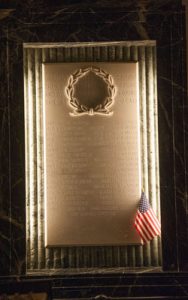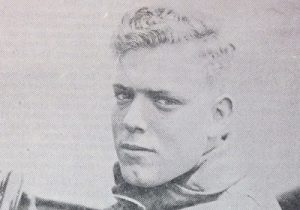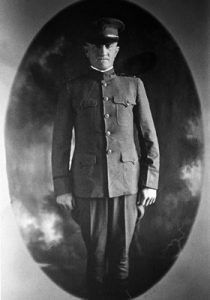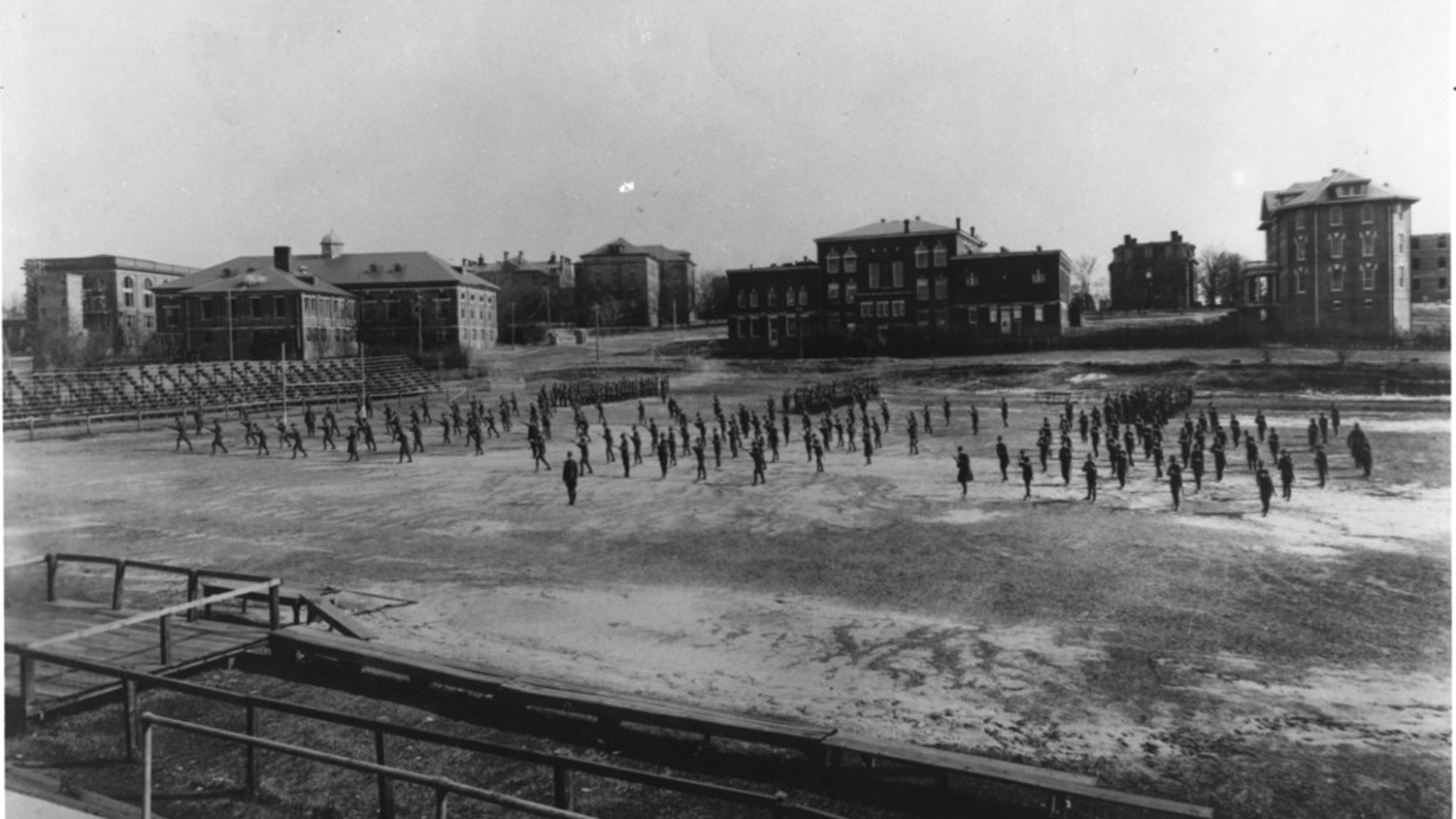- The Names in the Belltower
- Note: The North Carolina Museum of History opens a two-year exhibit about a North Carolina soldier’s experiences on the battlefields of France with a day-long centennial celebration from 10 a.m.-4 p.m. on Saturday.
They had no idea how much their world, and their legacies, would change. One day they were students, rural farm boys (and a few farm girls) who had come to Raleigh from North Carolina’s 100 counties with a dark cloud of a foreign war hanging over their heads.
On April 6, 1917—100 years ago today—the United States declared war on the German Empire to enter “The War to End War,” and the newly renamed North Carolina State College of Agriculture and Engineering changed forever.
Each of the students gave up something. Many gave up their education. Some gave their lives. Most were scarred forever.
Nearly 100 students immediately withdrew from school to enlist. The school changed from its traditional grey military uniforms to U.S. Army-issued olive drab. School-required afternoon military drills on the Red Diamond Field were increased from three to five days a week.
“The school began to have the atmosphere and appearance of an infantry camp,” wrote early college historian David Lockmiller in 1939.
In fact, that’s what it became. In the fall of 1918, all 593 students were organized into the Student Army Training Corps, a military unit of five infantry companies and one naval section. Each student received free college expenses and $30 per month in military pay.
“In a sense, the government commandeered the College,” Lockmiller wrote, “and the administration, faculty, and students loyally gave up their old studies and customs and cooperated in a program designed to win war.”

The school had already been touched by the war, from increased agriculture activity to aid the Europeans who had been fighting since 1914 to war classes as part of the Reserve Officers Training Corps that was formed in 1916.
Alum George Fletcher Sedberry of Fayetteville had already become the school’s first fatality of the war when he and seven other Americans died on British steamship Marina, which was sunk by a German U-boat off the coast of Ireland in 1916.
The school, Raleigh and the country were gearing up to be fully prepared for all-out war in 1919. Before any of the SATC officers were ever commissioned, however, the war abruptly ended with the armistice of Nov. 11, 1918. Though some remained in military pursuits, most students received an honorable discharge from their military duties and returned to their studies for the 1919 spring semester.
Without a doubt, that declaration of war, and the long-range effects, changed the landscape of the tiny little school on the western edges of Raleigh, a town of less than 20,000 that at the time was smaller than Winston-Salem, Charlotte, Wilmington and Asheville.
In all, 1,897 NC State students or alumni served in the First World War. The 34 who died in action, from illness or while training, are remembered in the NC State Memorial Tower, the campus icon that is dedicated to those who were lost in the war.

Some became real heroes. James Henry Baugham, enrolled in school and a member of the varsity football team for barely two months, took off for France in the fall of 1917 to become one of 180 American volunteers to make combat flights for the Lafayette Flying Corps as part of the French Air Service. He was twice shot down over the battlefields of France, surviving the first but suffering mortal wounds in the second. He earned the French Croix de Guerre with two palms and the French Medal Militaire.
Raleigh’s James Allen Higgs, a 1910 civil engineering graduate, was awarded a special war medal after he was shot down three times from observation balloons over the battlefields of France. Each time, he went back up in a new balloon.
Madison native Robert Opie Lindsay—a textiles major who had played basketball, served as business manager of the school paper and editor of the Agromeck—became the only North Carolina-born pilot to earn the distinction of flying ace, with six confirmed kills in air battles, while twice being shot down from 20,000 feet. During World War II, he organized the Oklahoma Air National Guard and served as the commanding officer of Fort Sill.

Raleigh native Frank Thompson—an early athletics hero when the school was known as the North Carolina School for Agriculture and Mechanic Arts, the head baseball coach at NC State and both the head football and baseball coach at Wake Forest College—enlisted as a lieutenant in the 15th Machine Gun Battalion at the age of 31 and died in action on the battlefield at St. Mihiel, France. NC State’s first campus gymnasium and current theater, Thompson Theatre, is named in his memory.
Some were local sons and daughters. Alexander Holladay Pickell, grandson of inaugural school president Alexander Holladay, died of pneumonia at a Naval Training Reserve in Massachusetts. Eliza Riddick, niece of school president Wallace Carl Riddick, died while comforting more than 500 students and faculty who were consumed in the Spanish flu pandemic of 1918, which killed 10 times more people worldwide than the war. In addition to Riddick and fellow nurse Lucy Page, 13 enrolled students died of the flu.
Dozens of faculty enlisted as well. Future chancellor and double-engineering graduate John C. Harrelson left his post as a math professor to join the Army, overseeing a company of mostly NC State alumni in the Coast Artillery Corps at Fort Caswell. He was promoted to colonel, the highest rank earned by an NC State alum in the war.
William C. Lee, a starting fullback on the NC State football team in the fall of 1916, enlisted as an infantry soldier in the spring of 1917 and, after the war, worked his way through the ranks to become the world’s leading expert in airborne infantry combat. The Dunn native is remembered as the “Father of the U.S. Airborne” and the architect of the Allied Forces airborne invasion of France during World War II.
Just off NC State’s campus, from the outlying community of Method all the way to House’s Creek Township, land that originally belonged to Raleigh founder Joel Lane and that was later used as a Confederate training camp during the Civil War was leased by the U.S. Government and turned into Camp Polk. It became one of three major military training grounds in North Carolina, along with Camp Greene in Charlotte and Camp Bragg in Fayetteville.
In September 1918, Camp Polk was designed to become the country’s only training ground for the deadly new fighting machines known as “tanks.” The state fair, held across Hillsborough Street from the NC State campus, was canceled for that fall and the exhibition grounds were turned into a camping area. The grandstands were turned into a large garage for lumbering used British training tanks that had been recovered from the battlefields of France and 16,000 soldiers and construction workers moved in, ready to reshape all of Raleigh.
And just like that, the war ended, leaving some 15 million board-feet of lumber, delivered diligently by train, lying around to waste away before being sent overseas to rebuild France.
By Jan. 1, 1920, what was to have been Camp Polk was turned over to the state of North Carolina, which developed the former farmland for agricultural research and a prison farm until the 1940s. Following the war, more than one-third of the school’s students were rehabilitating former soldiers who had been injured in battle.
- Categories:



